In tech, terms like “cloud” often have multiple interpretations, reflecting its versatile nature. While “cloud” suggests a broad concept, it’s essential to understand its specifics. Contrary to its mystical implication, cloud computing isn’t vastly different from conventional computing. It uses the same foundational server hardware.
The distinction lies in cloud architecture’s ability to offer its resources online. By connecting servers globally, it creates a robust computing network accessible from any internet connection. This adaptability has been crucial for organizations transitioning to remote work due to COVID-19.
Overview
Cloud computing has become a common term over the last decade, but the service sometimes creates confusion. With all the new cloud options and the phrase, “as a service” seemingly tacked onto everything imaginable, it’s helpful to take a step back and look at the differences between the main types of cloud deployment and the different types of cloud computing services.
Types of Cloud Deployment
Cloud deployment describes the way a platform is implemented, how it’s hosted, and who has access to it. All cloud computing deployments operate on the same principle by virtualizing the computing power of servers into segmented, software-driven applications that provide processing and storage capabilities.
Public Cloud
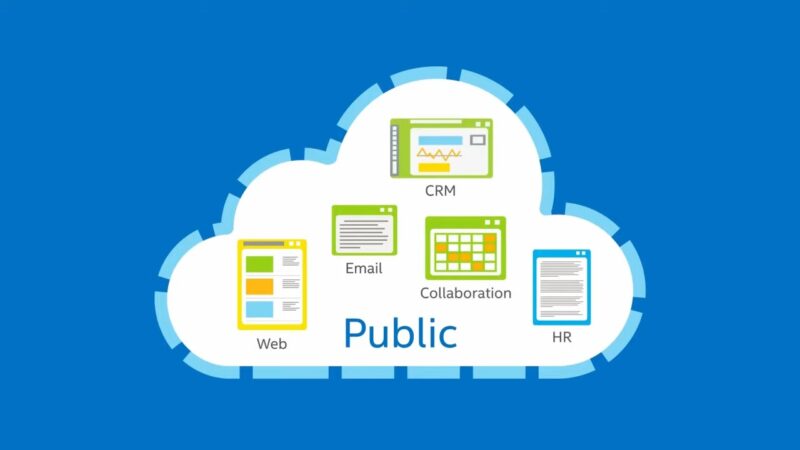
Some public cloud examples include those offered by Amazon, Microsoft, or Google. These companies provide both services and infrastructure, which are shared by all customers. Public clouds typically have massive amounts of available space, which translates into easy scalability. A public cloud is often recommended for software development and collaborative projects.
Companies can design their applications to be portable so that a project that’s tested in the public cloud can be moved to the private cloud for production. Most cloud providers package their computing resources as part of a service.
Public examples range from access to a completely virtualized infrastructure that provides little more than raw processing power and storage (Infrastructure as a Service, or IaaS) to specialized software programs that are easy to implement and use (Software as a Service, or SaaS).
Pros & Cons of Public Cloud Services
The great advantage of a public cloud is its versatility and “pay as you go” structure that allows customers to provision more capacity on demand. Not only does this make your system scalable, but it does so in a way that doesn’t require a large capital expenditure. There are significant costs associated with IT growth from the hardware and space required to maintenance and staff resources.
Further, the benefit of hosted cloud services means you tap into your provider’s security and disaster recovery plan. As such you’re ensuring that you are compliant with any industry standards and that your data is secure. Should there be a disaster of any kind, your system will have built-in redundancies to keep you up and running. Again, a fully realized disaster recovery plan and a network with redundancies can be costly.
On the downside, the essential infrastructure and operating system of the public remain under full control of the cloud provider. Customers may continue to use the platform under the terms and conditions laid out by the provider, but they may have difficulty repatriating their assets if they want to change providers.
Should the provider go out of business or make significant changes to the platform, customers could be forced to make significant infrastructure changes on short notice. There’s also the risk of an unpatched security vulnerability in the architecture exposing customers to risk.
Private Cloud
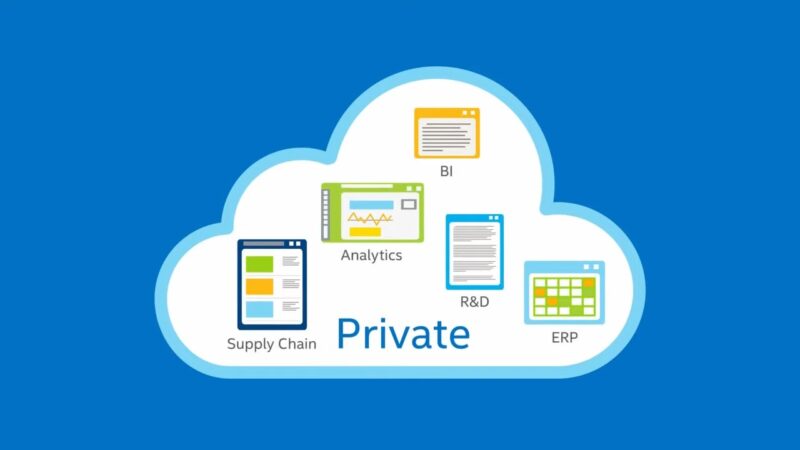
Private clouds usually reside behind a firewall and are utilized by a single organization. A completely on-premises cloud may be the preferred solution for businesses with very tight regulatory requirements, though private clouds implemented through a colocation provider are gaining in popularity.
Authorized users can access, utilize, and store data in the private cloud from anywhere, just like they could with a public cloud. The difference is that no one else can access or utilize those computing resources.
Pros & Cons of Private Cloud Services
If controlling the environment is essential, as are tight security regulations because of your industry, private cloud solutions offer both security and control. The additional control offered by a private cloud makes it easier to restrict access to valuable assets and ensures that a company will be able to move its data and applications where it wants, whenever it wants.
Furthermore, since the private cloud isn’t controlled by an outside vendor, there’s no risk of sudden changes disrupting the company’s entire infrastructure. A private cloud solution will also not be affected by a public provider’s system downtime. Still, you do get the technical support offered by your partner as well as their disaster recovery.
However, the benefits associated with a private cloud come at a cost. The company that owns the cloud is responsible for both software and infrastructure, making this a less economical model than the public cloud. Further, private clouds lack the versatility of public clouds. They can only be expanded by adding more hardware and storage capacity, making it difficult to scale operations quickly, or frugally, should the business need arise.
Hybrid Cloud
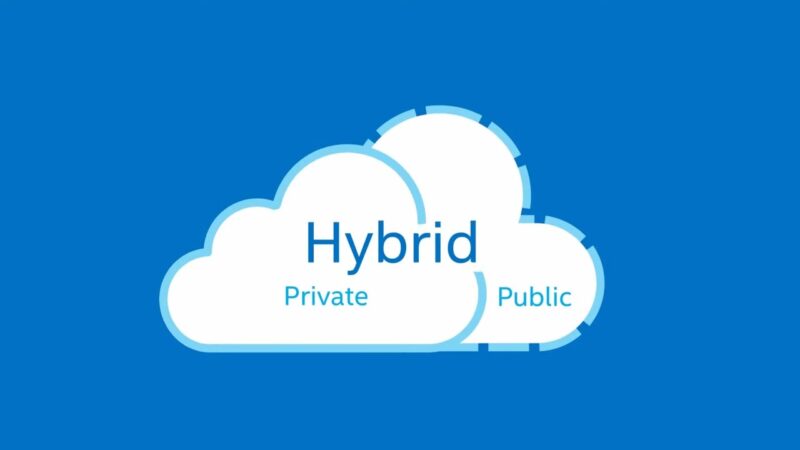
Simply put, hybrid clouds combine public clouds with private clouds. They are designed to allow the two platforms to interact seamlessly, with data and applications moving smoothly from one to the other. It’s the perfect solution for a business or organization that needs a little bit of both options, usually dependent on industry and size.
There are two commonly used types of hybrid cloud architecture. Cloudbursting uses a private cloud as its primary cloud, storing data and housing proprietary applications in a secure environment. When service demands increase, however, the private cloud’s infrastructure may not have the capacity to keep up. That’s where the public cloud comes in.
A cloudbursting model uses the public cloud’s computing resources to supplement the private cloud, allowing the company to handle increased traffic without having to purchase new servers or other infrastructure.
The second type of hybrid cloud model also runs most applications and houses data in a private cloud environment but outsources non-critical applications to a public cloud provider.
This arrangement is common for organizations that need to access specialized development tools (like Adobe Creative Cloud), basic productivity software (like Microsoft Office 365), or CRM platforms (like Salesforce). Multi-cloud architecture is often deployed here, incorporating multiple cloud service providers to meet a variety of unique organizational needs.
Pros and Cons of Hybrid Services
The primary advantage of a hybrid cloud model is its ability to provide the scalable computing power of a public cloud with the security and control of a private cloud. Data can be stored safely behind the firewalls and encryption protocols of the private cloud and then moved securely into a public cloud environment when needed.
This is especially helpful in the age of big data analytics when industries like healthcare must adhere to strict data privacy regulations while also using sophisticated algorithms powered by artificial intelligence (AI) to derive actionable insights from huge masses of unstructured data.
Because of the combination of the two cloud models, it can be cost-effective, though the initial expenditure for the private cloud should be considered. These costs can, in some ways, be recouped later, when scalability and growth can be handled on the public cloud when that becomes necessary.
Finally, it’s worth noting that you’ll want to work with a service provider who has significant experience in the hybrid cloud model as there are potential performance and security risks inherent to the need for the two different servers (public and private) to communicate and share data.
Community Cloud
Although not as commonly used as the other three models, community clouds are a collaborative, multi-tenant platform used by several distinct organizations to share the same applications. The users are typically operating within the same industry or field and share common concerns in terms of security, compliance, and performance.
In essence, a community cloud is a private cloud that functions much like a public cloud. The platform itself is managed privately, either in a data center or on-premises. Authorized users are then segmented within that environment. These deployments are commonly used by government agencies, healthcare organizations, financial services firms, and other professional communities.
Pros & Cons of Community Cloud Services
As with the other models, scalability is a benefit, and at a cost that can be shared across organizations. Further, because of common security needs, organizations can rest easy knowing that they’re fully compliant with any industry regulations and that it’s in the best interest of their “digital” neighbors to monitor this as well. Similarly, decision-making regarding changes to the systems is collaborative, ensuring, in many ways, that decisions are made in the best interests of the group.
Even with the shared space, the system remains highly flexible, with individual organizations able to set access controls and allow the system to adjust to the demands of an organization, shifting resources if necessary.
While all of these are strengths, unfortunately, they come with a downside as well. The shared storage and bandwidth can create issues with prioritization and performance as servers adjust to demands. And, because the storage space is shared, data security can be a concern. It’s just not practical for most businesses for a variety of reasons, most of which have to do with the potential pitfalls.
What is a Multi-Cloud Model?
In some cases, a single public cloud isn’t enough to meet an organization’s computing needs. They turn instead to multi-clouds, a more complex hybrid cloud example that combines a private cloud with multiple public services. While a hybrid cloud always consists of a public and private cloud, a multi-cloud environment is a bit more varied on a case-to-case basis.
In this arrangement, an organization’s IT infrastructure consists of multiple public clouds from multiple providers, although it may access those clouds through a single software-defined network. A private could certainly be part of a multi-cloud architecture, but it is usually more isolated from its public cloud counterparts.
The purpose of a multi-cloud model is versatility and specialization. In enterprise-level organizations, for example, not every department has the same cloud needs. A marketing department, for instance, needs different types of computing tools than a research or human resources department. Rather than trying to create a one-size-fits-all solution, companies can pick and choose from existing public cloud providers to ensure that each department has a solution catered to their specific needs.
Multi-cloud models also offer reassurance because they don’t leave organizations dependent upon a single cloud provider. This can decrease costs and increase flexibility in the long run while also avoiding the problem of vendor lock-in.
When combined with private cloud assets, multi-cloud deployments allow organizations to accomplish multiple goals at one time without having to radically expand or rethink their existing infrastructure.
Hybrid Cloud vs Multi-Cloud: Which One is Right for You?
As with most questions facing important IT infrastructure issues, it depends.
The key differentiator to keep in mind is that multi-models involve using separate cloud environments to perform separate tasks. If an organization needs its IT infrastructure to be able to accommodate the conflicting demands of different departments, then it probably needs to pursue a multi-cloud deployment.
The sales team may need the CRM features offered by a specific provider, while software programmers may favor different types of cloud computing environments that offer superior storage and processing capacity.
Large organizations with divisions existing in separate “silos” will typically find that multi-cloud solutions address more of their business needs. At the executive level, CIOs will find the cost efficiencies and versatility of multiple strategies appealing because it gives them the power to leverage providers against one another to drive down IT costs.
It also helps them maintain a level of independence that protects them against any sudden changes a cloud vendor may spring on them once the organization is already locked into and dependent upon a single platform.
On the other hand, hybrid cloud models offer a lot of advantages. Since they only involve the interconnections between two environments, they are easier to set up and scale. By using the private cloud to locate sensitive data and running front-end applications in the public cloud, organizations can reduce their exposure to potential security threats and keep a closer watch over activity within their cloud ecosystem.
Since public cloud computing services can be offered on a “pay for what you use” model, hybrid clouds can reduce overall IT spending while still allowing companies to scale up processing power when they need it.
Since a hybrid model is more custom-built to cater to the specific needs of an organization, it gives IT decision-makers more control over their deployments. This level of customization can be tremendously valuable for smaller companies that have a very clear idea of what they need from their infrastructure and it should be optimized to deliver superior services.
In many ways, this adaptability mirrors how modern logistics operations have evolved. Businesses seeking efficiency and scalability in their fulfillment processes often turn to specialized partners that can flex with demand—much like hybrid cloud systems do with computing power.
For instance, choosing the best 3PL for supplements allows growing health and wellness brands to manage inventory, storage, and distribution through a responsive external network, freeing them to focus on innovation rather than infrastructure. Both strategies—cloud and logistics—highlight the power of flexible outsourcing to drive performance and growth.
Why Choose?
Of course, for many organizations, the choice between a hybrid cloud model and a multi-cloud model is a false dichotomy. There’s no reason why a multi-cloud environment can’t incorporate the features of a hybrid cloud.
While this is necessarily a more complex solution that requires careful implementation and security considerations, private cloud environments can be integrated into multiple public clouds to allow different users across an organization to access both the data and cloud services they need to do their work more effectively.
Types of Cloud Computing Services

All public cloud computing services are built upon the same conceptual framework of remote infrastructure powered by servers housed in a data center. Since there are so many similarities between them, it’s helpful to think of computing as a pyramid, comprised of three layers. Each layer is more specialized than the one below it, but it’s built upon the same basic structure. The lower layers are much broader, representing their versatility, customizability, and wide range of applications, while the upper layers are narrower because they’re purpose-built for a specific task.
Infrastructure as a Service (IaaS)
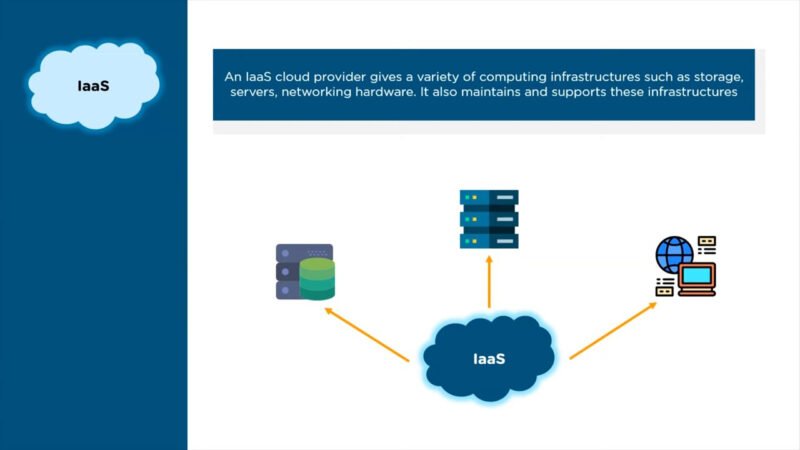
As the foundation of the cloud computing pyramid, IaaS is the most comprehensive and flexible type of cloud service available. Essentially, it provides a completely virtualized computing infrastructure that is provisioned and managed over the Internet. An IaaS provider manages the physical end of the infrastructure (servers, data storage space, etc.) in a data center, but allows customers to fully customize those virtualized resources to suit their specific needs.
With IaaS, the customer can purchase, install, configure, and manage any software they need to use, including things like operating systems, middleware, applications, business analytics, and development tools. Highly scalable, companies only pay for the infrastructure they use, allowing them to scale their computing needs as needed without having to build out additional capacity.
IaaS eliminates the capital expense of building up in-house infrastructure. It’s a great option for small companies and startups that don’t have the resources to purchase the hardware and software needed to create their network internally. It also takes the day-to-day burdens of managing computing infrastructure off the hands of IT departments, freeing them to focus on core business drivers instead of troubleshooting.
Since the IaaS provider continuously updates their system with the latest software and updates patches, it’s easier to get new programs and applications up and running. IaaS provides the latest in security protections and usually offers services like disaster recovery to go along with their uptime reliability SLAs.
- Examples of IaaS: Microsoft Azure, Amazon Web Services (AWS), Cisco Metacloud, and Google Compute Engine (GCE).
Platform as a Service (PaaS)
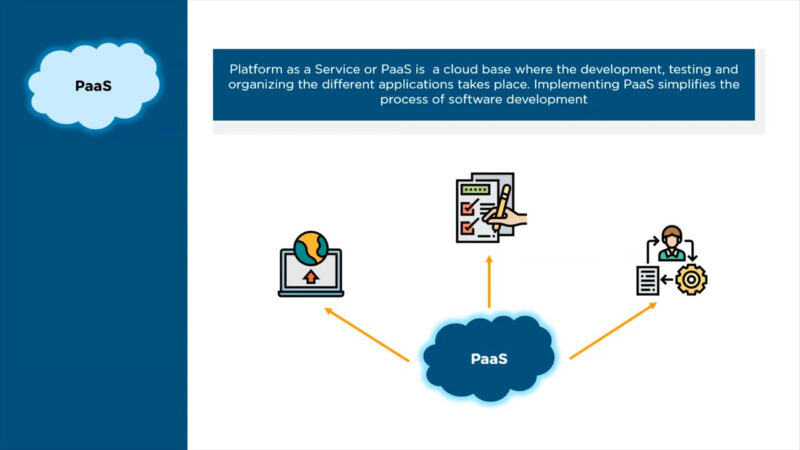
Situated a bit higher up the cloud computing pyramid is PaaS. Whereas IaaS delivers all the tools available through the cloud and leaves it to customers to build whatever suits their needs, PaaS is a bit more specialized. Rather than pure infrastructure, PaaS provides the framework needed to build, test, deploy, manage, and update software products. It utilizes the same basic infrastructure as IaaS, but it also includes the operating systems, middleware, development tools, and database management systems needed to create software applications.
PaaS is extremely helpful for any company that develops software and web-based applications. Many of the tools needed to develop for multiple platforms (computers, mobile devices, browsers, etc.) can be quite expensive. By using PaaS, customers can access the development tools they need, when they need them, without having to purchase them outright.
Since the platform is accessible over the internet, remote development teams can all access the same assets to speed up product development. Most PaaS tools provide extensive pre-coded applications built into the platform, which can greatly reduce coding time and help companies get their products to market faster.
- Examples of PaaS: AWS Elastic Beanstalk, Apache Stratos, Google App Engine, and Microsoft Azure.
Software as a Service (SaaS)

For most people, SaaS is the most familiar form of computing. Situated at the top of the pyramid, SaaS is a fully-developed software solution ready for purchase and use over the internet on a subscription basis. The SaaS provider manages the infrastructure, operating systems, middleware, and data necessary to deliver the program, ensuring that the software is available whenever and wherever customers need it.
Many SaaS applications run directly through web browsers, eliminating the need for downloads or installations. This greatly reduces software management issues for internal IT teams and allows companies to streamline their operations with hybrid and multi-cloud deployments.
SaaS applications allow companies to get up and running very quickly as well as scale operations rapidly. There’s no need to purchase or deploy the hardware and software used to deliver their business services.
Even sophisticated enterprise-level applications, such as customer relationship management (CRM) or enterprise resource planning (ERP) programs, can be easily accessed by the smallest organizations, providing them with tools that allow them to grow their businesses more effectively than ever.
- Examples of SaaS: Microsoft Office 365, Salesforce, Cisco WebEx, and Google Apps.
Function-as-a-Service (FaaS)
Often known as serverless computing, FaaS allows customers to execute code responsively without having to allocate processing resources ahead of time. The cloud provider handles the infrastructure, allowing the customer to focus strictly on deploying application code. Functions scale automatically, making them an excellent fit for dynamic workloads that fluctuate in terms of resource consumption. Customers only pay for the resources they use, making FaaS the most accurate form of “pay-as-you-go” cloud computing.
Most FaaS applications are quite simple and can be deployed very quickly. The cloud customer just needs to upload the compiled function code and tell the platform how to provision resources when it executes. New instances of the function can be scaled on demand, and when the function is at rest, it doesn’t consume any resources. The primary drawback to FaaS is execution time.
Since functions need to provision resources each time they run, there can be slight performance lags if the application requires a lot of computing power or executes during peak usage times. Applications also have to be stateless, so they can’t store data locally. Most FaaS services are available through major cloud providers like AWS and Azure, which can result in vendor lock-in.
- Examples of FaaS: AWS Lambdas, and Azure Functions.
Colocation and the Cloud
There are a variety of technical and business reasons why companies are transitioning away from owning their own data centers, and many of these reasons have become associated with the cloud. Different types of cloud computing configurations are putting unprecedented computing power into the hands of entrepreneurs for prices that would have been unthinkable a decade ago.
Cloud deployments are allowing small businesses to reach new customers and are speeding up the pace of scientific development. The advent of virtualized and cloud-based hosting solutions gives IT viable options for improving network speed and performance. Arguably, they also equip teams to deliver greater business value by helping reduce overhead and CapEx and enabling infrastructure scalability.
Not to mention, operating a data center isn’t a core competency for many businesses, and cloud-based solutions certainly remove data center management tasks from internal IT talent’s to-do list.
A colocation provider can be the “x-factor” in optimizing this hybrid cloud deployment, equipping IT teams with the interconnection and connectivity to spin up cloud environments quickly and affordably while maintaining local infrastructure.
There are several important advantages to a colocation-cloud hybrid IT model:
Seamless Flexibility
A misconception about both colocation and the cloud is that they’re an “either-or” investment. As mentioned, the two can be deployed together as part of a hybrid cloud model, enabling more streamlined application management. For instance, a business may want to run its mission-critical systems within the walls of its colocation facility but use the environment for development and testing. A colocation provider can create a secure path to the cloud and allow this business to move necessary applications and data to and from the cloud seamlessly.
Greater Scale and Support
Many colocation providers offer a variety of managed services in addition to space and power. This creates a total data center solution for businesses, equipping them with the power, space, and cooling solutions to scale infrastructure when needed plus the expert, on-site support to manage the environment without requiring bandwidth from internal IT talent. Furthermore, moving to a colocation facility can help reduce your CapEx and simultaneously tap into the latest data center technologies.
Colocation providers also offer customers “burstable” services — businesses gain the ability to use and pay for cloud services as necessary, as opposed to investing in a maximum-level, year-long contract. This gives businesses a cost-effective cloud option that can scale with their demands and doesn’t force them to move all their infrastructure to the cloud at once.
Reduced Risk
One of the greatest benefits of colocation over the many different types of cloud computing is compliance. It can be tricky to align cloud deployments with the strict compliance and security requirements many industries face. Top colocation providers are often certified under the industry’s most stringent standards, giving businesses a viable option if they’re considering moving infrastructure off-site but still have security or compliance concerns.
How to Choose the Right Colocation Provider
Colocation offers many benefits, but identifying the right provider can be challenging for companies. Perhaps the greatest challenge in selecting a colocation provider is resisting the urge to approach the investment as a commodity. The right colocation provider can offer much more than just power and space — seamless integration with existing cloud environments is just one of many potential benefits of working with the right provider.
It’s important for businesses to clearly and proactively define the technical and business requirements they’re attempting to meet, and then evaluate potential providers based on their ability to help achieve those goals. From there, comparing pricing, feature sets, and service options becomes a whole lot easier.
What to Look For in a Cloud Services Provider
First and foremost, when looking for a services provider, you want to choose a company that not only knows but understands your business or industry. Familiarity with what your needs will be now, and looking forward, can be fundamental to your implementation and any necessary migration. The right colocation provider can accommodate the infrastructure needs of a private cloud network while also providing access to a wide range of public cloud services to build a sophisticated hybrid cloud architecture that provides unparalleled flexibility.
You want to ensure that you’re inquiring about security standards and protocols, what the provider offers, what’s out-of-the-box and what’s an add-on. What are the physical security measures in place? The logical security measures? And what mechanisms do they have in place to ensure adherence to those protocols? Similarly, if your industry has compliance standards, you want to ask about that upfront.
Another essential is to examine the Service Level Agreement (SLA). What does your provider offer in terms of a guarantee on capacity, response time, availability, and support? You don’t want to wait till there’s an outage or a problem with your system to discover that one of these elements isn’t going to meet your needs. While all service providers offer these in their SLA, it’s pretty standard, not everyone delivers.
Access and control are also important in terms of being able to meet your needs. How will the provider’s system integrate with yours? How much transparency is there? How much input might you have in terms of the needs of your business and system? While with a public cloud option, some of this will be limited, it’s essential to know that if you are having performance issues there is an opportunity for you to have input.
You’ll want that input if there are problems as well. For that reason, take very good luck with the kind of support offered by your provider. How easy is it to submit a trouble ticket? How responsive are they to those issues? What is the resolution process like? Similarly, ask who is providing the support. Is it a qualified technician or a call service who relays the info?
The bottom line is this: If you are in the market for a colocation partner, you want to make your research process as exhaustive as possible. Consider all possible scenarios, all possible needs, and how your provider can meet or exceed your service expectations while partnering with you for success.
Cloud computing has transformed the way companies around the world do business in ways that many people don’t even realize. Understanding the difference between various types of computing and identifying which one is the right fit for a growing business is tremendously important. As cloud services continue to proliferate, they will surely provide new opportunities for companies looking to innovate and drive business results. When looking to take advantage of these innovations and opportunities, you want to choose the right provider.
FAQ:
What is the difference between cloud computing and traditional hosting?
Traditional hosting typically involves a single server where a website or application is hosted. Computing, on the other hand, distributes the data across a network of interconnected virtual servers, offering more flexibility and scalability.
How secure is computing?
Cloud providers invest heavily in security measures, including encryption, firewalls, and authentication protocols. However, security also depends on the user’s practices, such as using strong passwords and regularly updating software.
Is computing more cost-effective than on-premises solutions?
While initial costs for cloud services might seem higher, in the long run, cloud computing often proves more cost-effective due to reduced maintenance, no need for hardware upgrades, and pay-as-you-go pricing models.
How does computing impact the environment?
Data centers are often more energy-efficient than traditional ones. By consolidating resources in state-of-the-art centers, cloud providers can reduce their carbon footprint. However, the overall environmental impact also depends on the energy sources the data centers use.
What happens if my cloud service provider goes out of business?
Reputable providers usually offer data portability, backup, and recovery solutions to ensure data integrity in such scenarios. It’s essential to have backup strategies and understand your provider’s terms of service.
Do I need a constant internet connection for computing?
While services are accessed over the internet, some providers offer offline modes for specific applications. However, to leverage the full potential of cloud computing, a stable internet connection is recommended.
Final Words
In the ever-evolving landscape of technology, cloud computing stands as a testament to the boundless possibilities of digital transformation. With its myriad of configurations and services, it offers businesses unparalleled flexibility, scalability, and opportunities for innovation.
As we navigate this vast cloud ecosystem, it’s crucial to align with a provider that resonates with our unique needs and visions. The journey through the clouds may seem intricate, but with the right partner and understanding, the sky is not the limit; it’s just the beginning.
As we look ahead, let’s embrace the cloud’s potential and shape a future where technology and ambition converge seamlessly.
Related Posts:
- VPLS vs MPLS: How They Are Different and Why You Need Both
- Edge Computing vs. Cloud Computing: What You Need to Know
- What is Cloud Computing? Everything You Need to Know
- Portable Homes: Types, Features, and How to Choose…
- Common Types of Maritime Accidents and How to Avoid Them
- Cluster Pays Slots and How They Work








